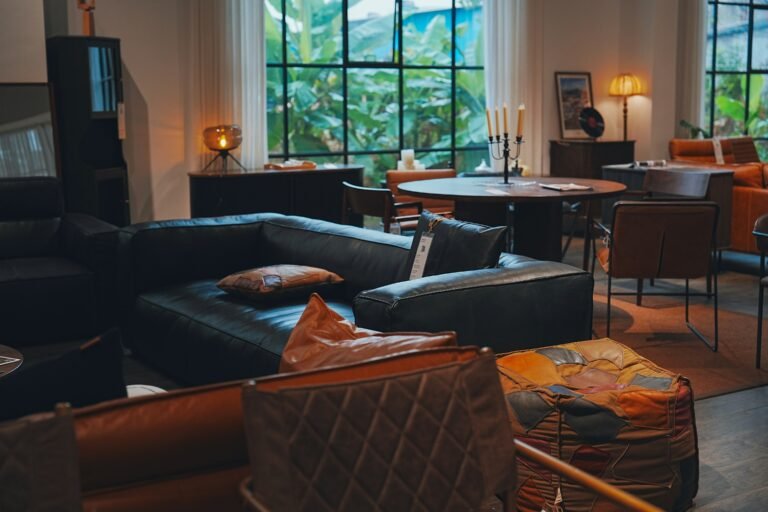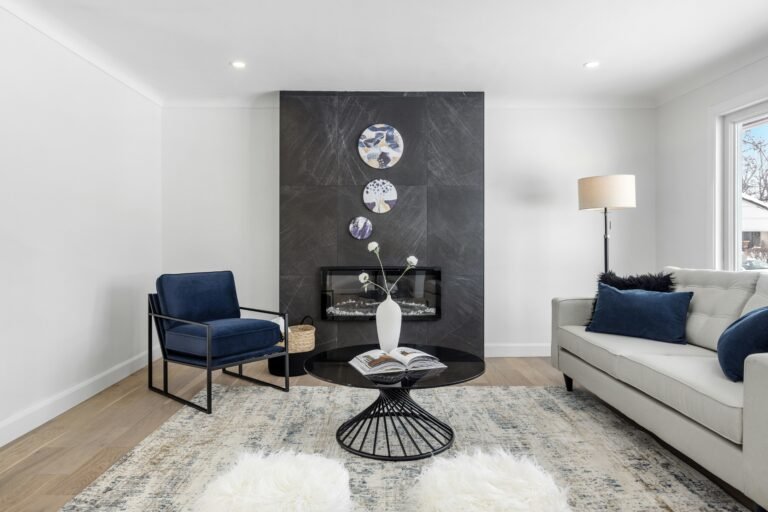How to Create a Stylish Mid Century Living Room on a Budget
This site contains affiliate links. I may earn a small commission, at no extra cost to you.
Introduction:
Ever looked at a glossy magazine photo of a Mid Century Living Room and thought, “Wow, I’d need to sell a kidney to afford that”? Yeah, I’ve been there. The sleek lines, rich woods, and that effortless sophistication make the mid-century look totally irresistible — but the price tags? Not so much.
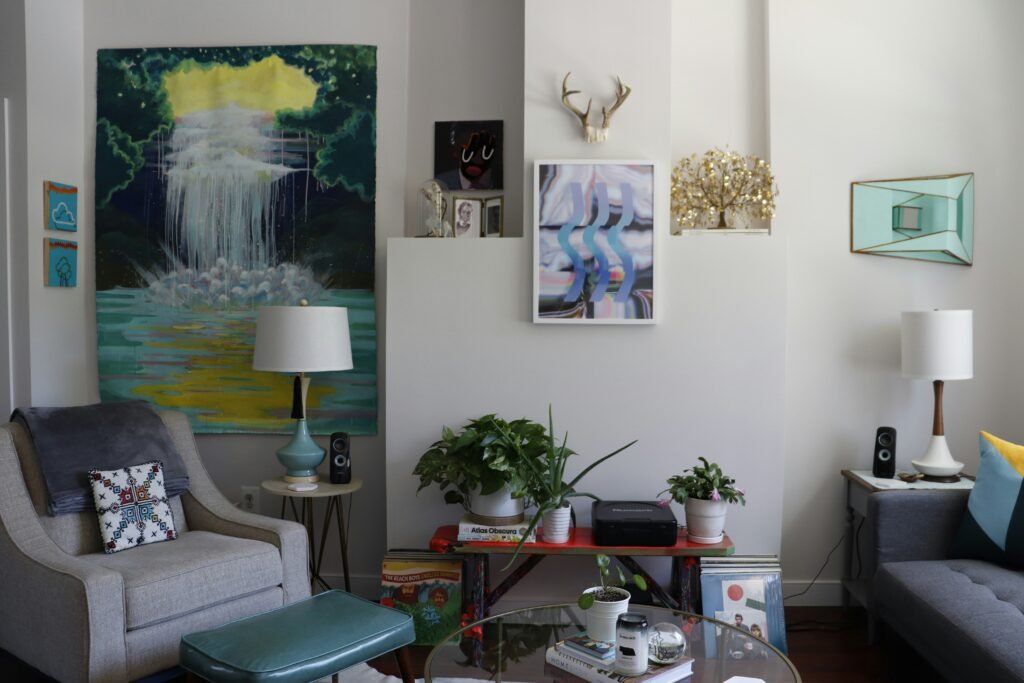
Here’s the good news: you don’t need a five-figure budget to create a stylish Mid Century Living Room on a budget. I’ve helped clients (and, honestly, done it in my own home) achieve that Mad Men-level charm without maxing out a credit card. You just need to know where to splurge, where to save, and how to make smart design choices that look high-end but cost next to nothing.
In my opinion, mid-century design is one of the easiest styles to recreate affordably — once you understand its essence. So, grab your coffee (or cocktail, no judgment), and let’s chat about how to pull this look off without selling your soul to the design gods.
What Makes Mid Century Design So Timeless (and Why It’s Perfect for Budget Decor Lovers)
Before we talk budgets, let’s get one thing straight — mid-century design isn’t about owning vintage furniture worth thousands. It’s about simplicity, balance, and thoughtful details.
In my experience, people overcomplicate it. They think they need Eames chairs or authentic teak credenzas to “get the look.” Truth is, you can nail the mid-century vibe without a single designer label — if you focus on what really defines the style:
- Clean, simple lines: Furniture with tapered legs, smooth surfaces, and no unnecessary fuss.
- Natural materials: Think walnut, oak, or faux-wood finishes that mimic the warmth of the real thing.
- Muted yet bold color palette: Earth tones mixed with pops of mustard, teal, or burnt orange.
- Functional design: Every piece serves a purpose (and often looks beautiful doing it).
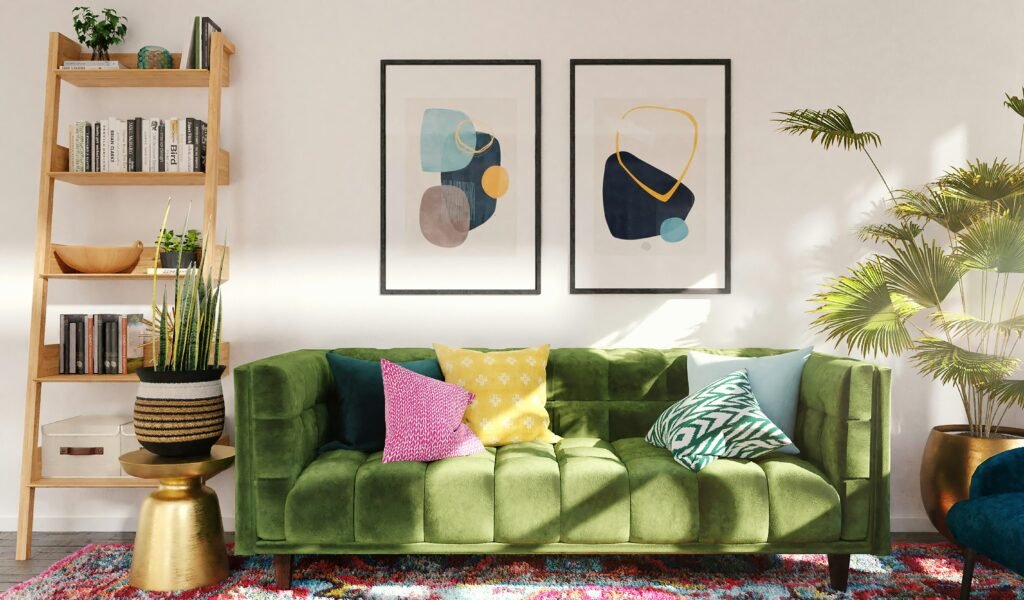
Ever wondered why this style has stuck around since the 1950s? It’s because mid-century interiors feel effortlessly cozy and timeless. There’s something universally appealing about a space that looks curated, not cluttered — which, in my opinion, is perfect for anyone decorating on a budget.
When you focus on form, function, and a bit of flair, you can create a stunning Mid Century Living Room on a budget that still feels expensive.
Step One: Understand Your Space (Before You Spend a Dime)
I always tell my clients — before you hit “add to cart” on that sleek walnut coffee table, you need to understand what your space is telling you.
In my experience, mid-century design works best when it complements your home’s existing features. Got big windows? Perfect — play them up with sheer curtains and plenty of light. Small living room? No problem — mid-century furniture tends to have an open, airy look that won’t overwhelm your space.
Here’s what I recommend doing before you start shopping:
- Assess your layout: Where does natural light fall? Which wall can host your main sofa or focal point?
- Measure your space: Trust me, nothing kills the vibe faster than an oversized credenza that blocks a doorway.
- Identify what you already own: Sometimes, the best budget decor move is simply reusing and restyling what you’ve got.
I once had a client who thought she needed all-new furniture for her living room redo. Turns out, all we did was refinish her coffee table, change out the rug, and swap in a few brass accents — and boom, instant mid-century charm.
So before you spend a single dollar, ask yourself: Can I repurpose or restyle something I already have? You’d be surprised how often the answer is yes.
Why “Less Is More” (Especially When You’re on a Budget)
Here’s the thing — mid-century style thrives on simplicity. If you try to cram every “retro” element into one room, it’ll feel more like a thrift store explosion than a design statement.
In my opinion, editing is where true design skill shows up. You don’t need ten statement pieces — you need three great ones that tell your story.
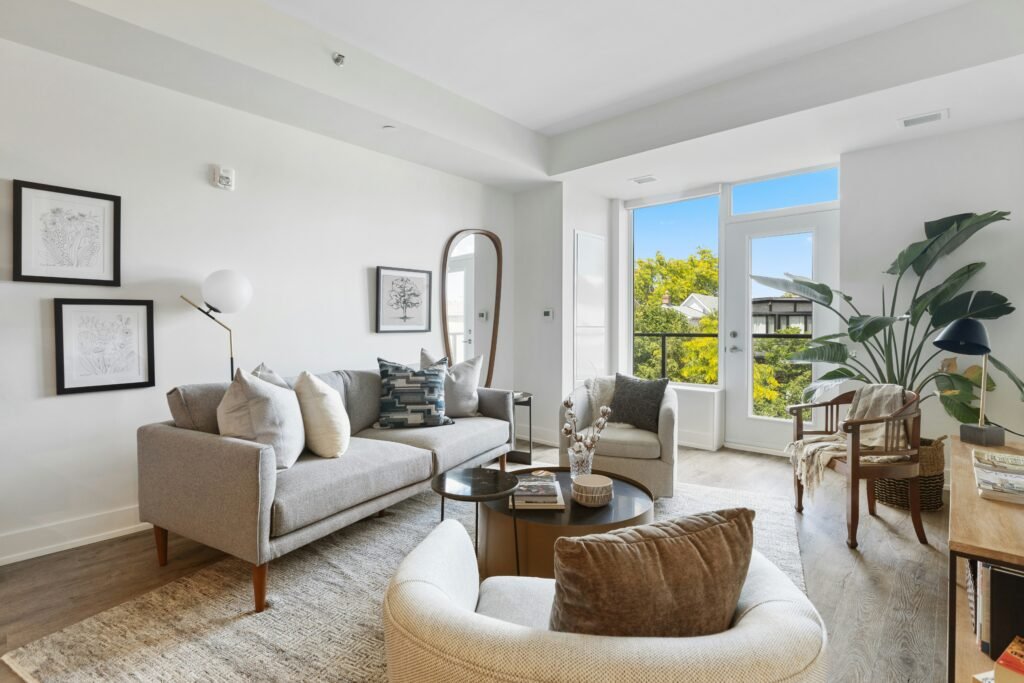
Here’s how I like to approach it:
- Pick one hero piece. This could be a vintage-inspired sofa, a wooden credenza, or even a bold armchair.
- Keep everything else simple. Neutral walls, minimal clutter, and purposeful accessories go a long way.
- Add contrast with texture. A velvet cushion here, a jute rug there — texture adds richness without adding chaos.
Ever noticed how expensive spaces feel calm? That’s not an accident. When you declutter, your furniture suddenly looks more expensive.
So if you’re trying to create a Mid Century Living Room on a budget, your best move might not be buying more stuff — it might be removing a few pieces and letting the design breathe.
The Secret Sauce: Mixing Vintage with Affordable Modern Finds
Now, let’s be real — not everyone has access to a vintage shop that doesn’t charge museum prices. But in my experience, the magic happens when you blend old and new pieces seamlessly.
For example:
- Pair a secondhand wood coffee table with a sleek modern sofa from IKEA.
- Mix vintage art prints with clean-lined frames from Target.
- Combine thrifted lighting with budget-friendly new decor like vases, throws, and plants.

The result? A layered, intentional look that feels curated — not “I bought everything in one afternoon.”
If you ask me, that’s the real beauty of creating a Mid Century Living Room on a budget: it pushes you to get creative. You’ll develop an eye for shapes, materials, and balance instead of relying on high-end price tags.
And trust me, once you pull it off, everyone will ask where you “bought” your style.
Choosing the Right Furniture: Spend Smart, Save Smarter
Let’s be honest — furniture is where people panic first when decorating a Mid Century Living Room on a budget. Everything looks perfect… until you see the price tag.
Here’s what I’ve learned from experience: you don’t need original pieces to nail the mid-century vibe. You just need furniture with the right shapes, proportions, and finishes.
So, what exactly should you look for?
1. Go for Tapered Legs and Clean Lines
In my opinion, nothing screams mid-century like a good pair of tapered wooden legs. Whether it’s your sofa, coffee table, or TV stand, that little detail instantly elevates the entire space.
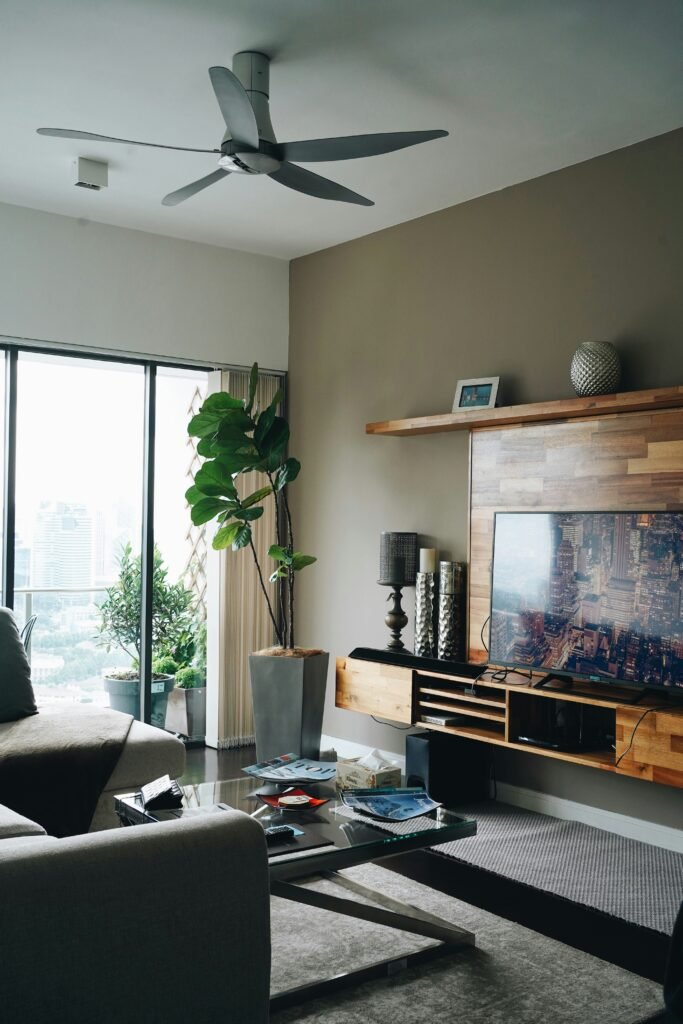
Look for:
- Sofas with low profiles and simple silhouettes
- Coffee tables with rounded edges (bonus points for walnut tones)
- Credenzas or sideboards with sliding doors and smooth handles
And no, you don’t have to buy them new. I’ve found some absolute gems on Facebook Marketplace and local thrift stores — a bit of sanding, fresh stain, and it’s showroom-worthy.
2. Choose Versatile Core Pieces
When you’re styling on a budget, versatility is your best friend. In my experience, neutral furniture (beige, gray, tan, or white) gives you the flexibility to switch up your decor later.
That way, when you get the urge to swap your mustard throw pillows for teal ones (because it will happen), you don’t have to replace your sofa too.
Think of your furniture as the “canvas,” and your decor as the “art.” Keep your canvas simple, and you’ll never get tired of the look.
3. Know Where to Splurge
I always tell clients: spend where you sit or touch. In other words, invest in a comfortable sofa or sturdy coffee table, and save on accessories.
Why? Because a high-quality sofa not only lasts longer but also anchors your space visually. You can fake expensive style with lighting or decor — but a bad sofa? Nope, it’ll betray you every time.
My go-to budget-friendly sources for mid-century inspired pieces include:
- IKEA: great for minimal designs and affordable side tables.
- Article: slightly higher priced but timeless quality.
- Target or Wayfair: surprisingly stylish mid-century collections if you know what to look for.
- Thrift stores & estate sales: your secret weapon for authentic vintage finds.
Ever scored a $50 teak table that looked like it came straight out of Don Draper’s apartment? I have — and it’s still my favorite conversation piece.
Picking the Perfect Mid Century Color Palette
Now let’s talk color — because even the cheapest room can look expensive with the right palette.
The Mid Century Living Room on a budget formula for color is simple:
Start neutral. Add warmth. Then sprinkle in personality.
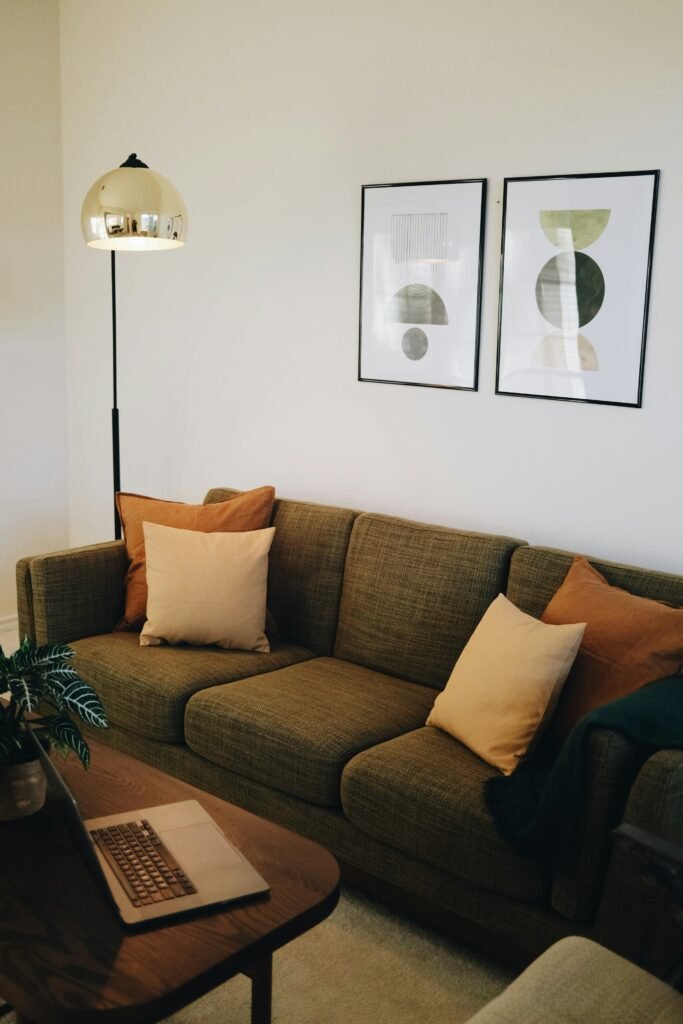
Here’s how I approach it:
1. Begin with Neutrals
Think white, ivory, soft gray, or even a warm beige base. Neutral walls and large furniture pieces give your room breathing space and make it easier to highlight the decor.
2. Add Earthy and Retro Tones
Mid-century design thrives on rich, earthy hues. My personal favorites?
- Mustard yellow (a classic mid-century accent)
- Olive green
- Terracotta
- Teal or navy blue
- Burnt orange
Even small touches of these colors — a throw pillow, an accent chair, or wall art — can instantly transform your space.
3. Keep It Balanced
Here’s a rule I live by: if everything pops, nothing pops.
Choose one or two bold colors max, and keep the rest neutral.
For example, a white room with a teal armchair and mustard cushions looks intentional. But throw in a red rug and purple lamp, and suddenly it’s giving “thrift store chaos” instead of mid-century charm.
Color harmony is key — and the best part? Paint is the cheapest design trick in the book. You can repaint your walls for under $50 and completely change the feel of your living room.
Lighting: The Unsung Hero of Mid Century Design
In my opinion, if you ignore lighting, you’re missing half the mid-century magic. The right lighting can make your budget decor look designer-level in seconds.

Here’s how to approach lighting for a Mid Century Living Room on a budget:
1. Layer Your Lighting
Avoid the “one overhead light and done” mistake. Instead, mix lighting types:
- Overhead lighting: A statement pendant or chandelier (look for atomic or sputnik-style designs).
- Floor lamps: Tripod or arched floor lamps with metal or brass finishes.
- Table lamps: Ceramic bases, dome shades, or textured details that add personality.
Layering these creates depth, warmth, and that cozy glow that mid-century rooms are famous for.
2. Choose Warm Light Bulbs
Here’s a quick but powerful tip: ditch the cool white bulbs.
Mid-century interiors look their best under warm light — it softens wood tones and enhances your decor’s color palette.
3. Shop Smart for Fixtures
I recommend checking sites like Amazon, Home Depot, or AllModern for affordable replicas. You can also thrift vintage lamps and simply change the shade or wiring (super budget-friendly).
One of my favorite design hacks? I once spray-painted a $10 thrifted lamp base in matte brass and paired it with a linen shade — it looked like something straight from West Elm.
So yeah, lighting isn’t just functional — it’s your secret weapon for elevating a budget room.
Budget Styling Tricks That Look High-End
Alright, you’ve got the furniture, color, and lighting down — now it’s time for the finishing touches that make your Mid Century Living Room on a budget look like you hired a designer.
1. Master the Art of Layering
Layering creates dimension and makes your space feel “lived-in” (in the best way). Combine materials like:
- Velvet cushions + linen throws
- Wooden coffee tables + metal trays
- Wool rugs + leather poufs
Mixing textures is what gives your room depth — it’s how you make inexpensive items feel intentional and sophisticated.
2. Use Mirrors and Art to Expand the Space
I love using vintage-style mirrors to open up a small room. Hang one opposite a window, and boom — instant light and visual space.

As for art, you don’t need to splurge on originals. Frame retro abstract prints or black-and-white photography for that minimalist gallery feel.
3. Plants Are Your Secret Weapon
Nothing breathes life (literally) into a room like greenery. Tall, sculptural plants like fiddle leaf figs or snake plants fit perfectly in the mid-century aesthetic.
And if you’re anything like me and can’t keep plants alive? Go for faux ones — just pick ones with realistic textures and matte finishes.
4. Swap Hardware for Instant Impact
A small but mighty upgrade: change the knobs and handles on your furniture.
I once swapped out plain silver handles for brass knobs on a thrifted sideboard — total transformation for under $15.
5. Curate, Don’t Clutter
Here’s the thing: a true mid-century room looks curated, not busy.
Instead of displaying everything you own, choose intentional pieces that tell your story — a vintage vase, a family photo in a retro frame, or that quirky ceramic bowl you picked up on vacation.
Remember, space is part of the design.
How to Nail the Layout (Because Flow Matters as Much as Furniture)
Okay, so you’ve got your color scheme, furniture, and lighting sorted — but here’s something most people overlook: a good layout is what makes your Mid Century Living Room on a budget actually feel stylish.
Ever walked into a room that technically had nice stuff but somehow looked off? That’s because everything was fighting for attention or blocking flow.
In my opinion, the mid-century style thrives on balance, openness, and breathing room. Here’s how to get it right:
1. Start with a Focal Point
Every living room needs an anchor — it could be your sofa, a statement credenza, or a beautiful piece of art. Once you choose it, build everything else around it.
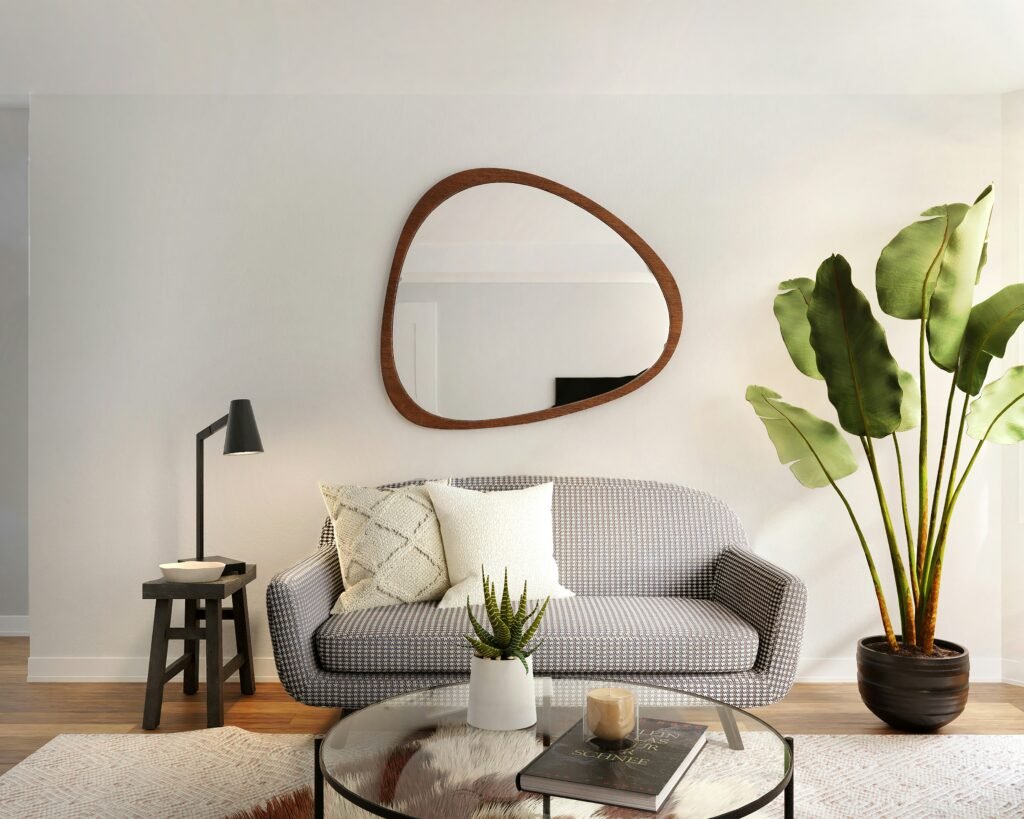
If your sofa faces a TV, center your rug and coffee table along that axis. If your art wall is your star, make sure your seating arrangement subtly directs the eye there.
The idea is to create harmony — not clutter.
2. Keep Traffic Flow Open
I always recommend leaving at least 2–3 feet of walking space between furniture pieces. In small rooms, this can be tricky, but that’s where smart furniture choice comes in — opt for sleek, open bases instead of bulky designs.
Here’s a little trick I use with clients: when in doubt, take a photo of your layout and squint at it.
If it looks crowded, it is.
3. Don’t Push Everything Against the Wall
This one’s a classic rookie mistake. Pulling your furniture slightly away from the walls can actually make your room feel larger and more intentional.
Try floating your sofa in the center and placing a console or low shelf behind it.
It creates layers, depth, and a designer-level feel — all without spending an extra dime.
Budget-Friendly DIY Projects That Add Designer Flair
Let’s be real: nothing makes your Mid Century Living Room on a budget feel more personal (and impressive) than a few creative DIYs.
And no, I’m not talking about spending weekends wrestling with power tools — just simple, smart updates that pack major style.
Here are my go-to ideas that I’ve used in both client projects and my own home:
1. DIY Wall Art
Abstract art was huge in mid-century interiors. And the best part? It’s ridiculously easy to fake.
Grab a large canvas, a few acrylic paints in your color palette (think terracotta, ochre, navy), and just go for it.
You’ll end up with something unique, modern, and totally budget-friendly.

I once made a $15 DIY canvas that now gets more compliments than any store-bought decor I own.
2. Refinish or Repaint Old Furniture
If you already have wooden furniture, a light sanding and a coat of walnut or honey stain can instantly give it that warm mid-century tone.
Even laminate pieces can be upgraded with peel-and-stick woodgrain vinyl or contact paper — I’ve done this myself, and trust me, it looks shockingly realistic.
3. Create a Gallery Wall
Print vintage ads, architectural sketches, or black-and-white family photos.
Frame them in slim, wood-tone or black frames, and arrange them in a clean grid.

It’s stylish, nostalgic, and 100% mid-century without spending hundreds on artwork.
4. Update Light Fixtures Yourself
You can often find old lamp bases for cheap at thrift stores.
Give them new life with a coat of matte spray paint (brass, black, or white) and a fresh linen or dome shade — and boom, it looks straight out of a high-end catalog.
5. Add a Statement Wall
If you’re feeling a little bold, choose one wall and paint it in a rich mid-century hue like olive green, rust, or navy.
This creates depth and gives your space that designer touch — and all it costs is a can of paint.
Accessorizing: The Final Layer That Brings It All Together
Accessories are where your Mid Century Living Room on a budget truly comes alive. But here’s where most people go wrong — they either overdo it or underdo it.
The secret? Balance personality with restraint.
1. Play with Patterns (But Don’t Overwhelm)
Mid-century decor loves geometric shapes, but moderation is key.
Go for one patterned rug or cushion set and keep the rest simple.
I personally love a bold geometric rug paired with plain velvet cushions — it adds energy without looking chaotic.
2. Incorporate Organic Elements
Mid-century design is all about warmth and nature. Bring in:
- Wooden trays
- Ceramic planters
- Woven baskets
- Rattan accents
These add texture and coziness while keeping your space grounded.
3. Add Metallic Touches
A little brass or gold goes a long way.
Swap in metallic picture frames, lamp bases, or mirror trims to add that subtle glow of sophistication.
I once found a vintage brass ashtray dish for $5 at a flea market — and it’s now my go-to decor accent. Little things like that make a space feel collected, not copied.
4. Books Are Your Secret Weapon
A stack of design books or vintage novels on your coffee table instantly makes your space feel more curated.
Pro tip: remove dust jackets for a cleaner, minimalist look.
Keep It Timeless: How to Avoid “Trendy Burnout”
The trick to creating a stylish Mid Century Living Room on a budget that lasts more than a few months? Focus on timeless design, not trends.
Here’s what I’ve learned (sometimes the hard way):
- Skip overly themed decor. A room full of atomic clocks and starburst mirrors can look kitschy fast.
- Choose classic shapes and natural materials. They never go out of style.
- Stick to a few bold accents rather than constantly chasing what’s “in.”
Mid-century interiors have survived seven decades for a reason — they balance function, form, and emotion.
If you get those three right, your space will feel modern no matter the year.
My Favorite Affordable Sources for Mid Century Decor
Let’s be practical for a second — where do you actually find these pieces without spending a fortune?
In my experience, here are the top places that consistently deliver:
- Thrift Stores: The best spot for genuine vintage furniture (bonus points for DIY potential).
- Facebook Marketplace: Hidden gems galore — just be patient and set alerts for “mid-century.”
- IKEA: Their minimalist lines blend perfectly with mid-century pieces.
- Target’s Project 62 Line: Inspired by mid-century aesthetics — modern, affordable, and easy to mix.
- Wayfair and Overstock: Great for budget-friendly sofas, lighting, and decor.
- Local antique shops or estate sales: You’d be shocked at how affordable authentic mid-century items can be if you know what to look for.
And here’s my little secret: pairing high-low items always wins.
Your guests won’t know (or care) whether your armchair cost $900 or $90 if the space looks cohesive and intentional.
Final Thoughts: You Don’t Need a Big Budget to Live Beautifully
If there’s one thing I’ve learned after years in design, it’s this — style has nothing to do with money.
You can absolutely create a show-stopping Mid Century Living Room on a budget if you:
- Focus on clean lines and warm tones
- Prioritize good lighting
- Mix vintage with modern finds
- Keep things intentional, not cluttered
In my opinion, the real luxury is when your space feels authentic — not like a Pinterest copy.
And when you’ve poured a bit of yourself into it (even if that’s through DIY art or thrifted furniture), it shows.
So next time someone tells you mid-century style is expensive, just smile and invite them over.
Because when they see your stylish, budget-savvy living room?
They’ll probably ask for your decorator’s number — and you can tell them, “Oh, it’s just me.”


